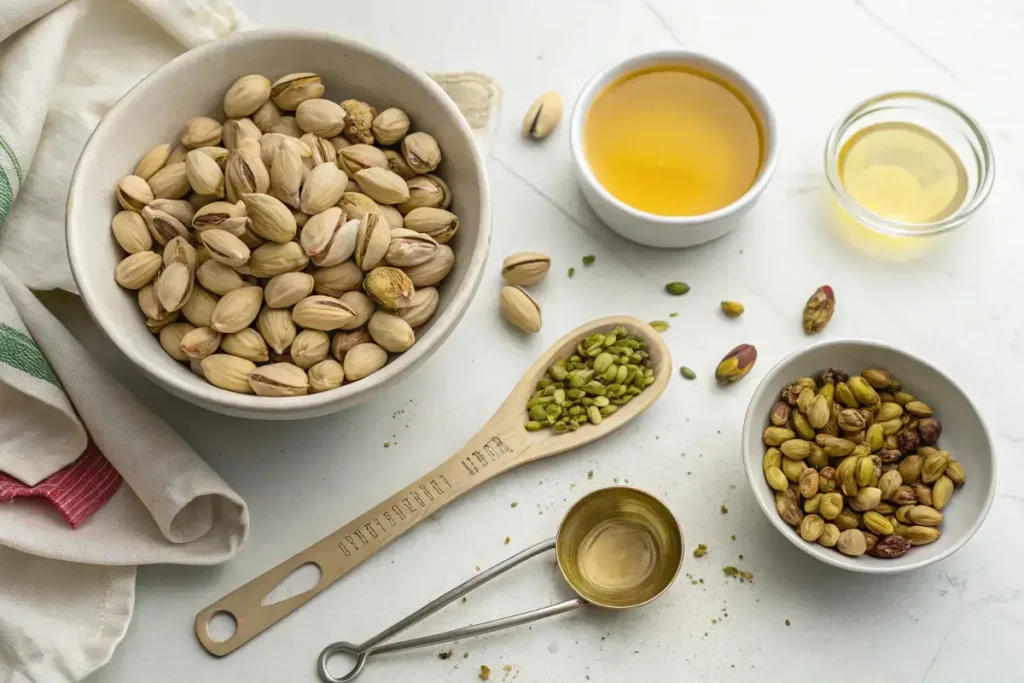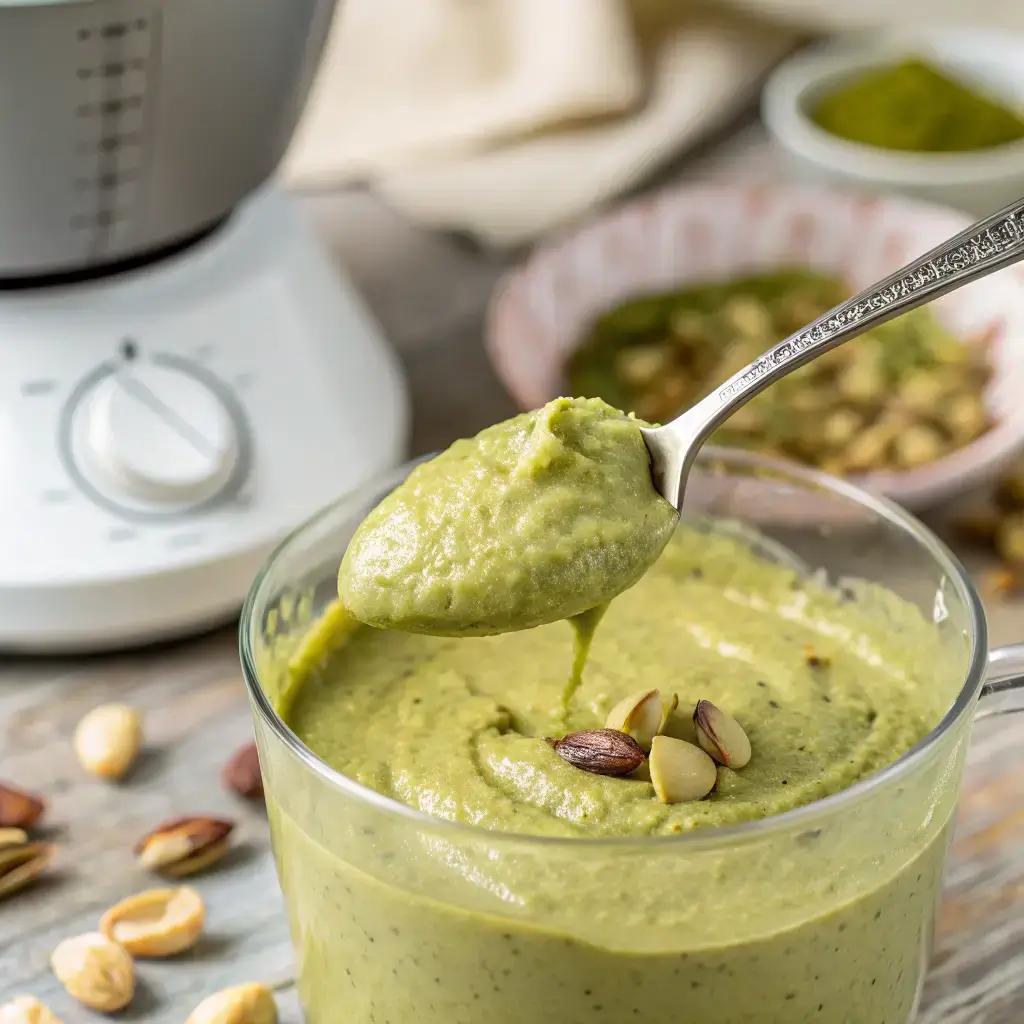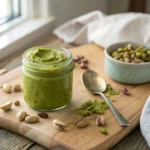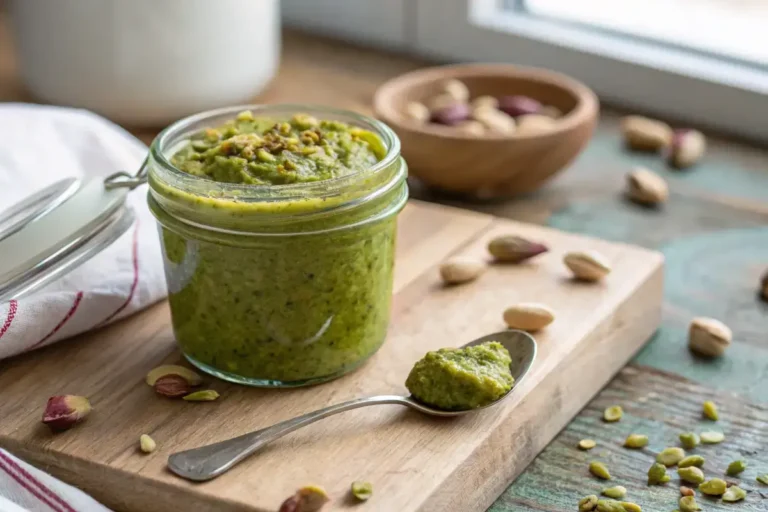Pistachio paste might sound fancy, but making it at home is surprisingly easy—and deeply rewarding. With just three ingredients, you can whip up a naturally sweet, buttery spread that takes desserts, sauces, and breakfasts to another level. In this guide, we’ll cover how to make homemade pistachio paste, how to store it, what to use it for, and why it’s worth making from scratch. Whether you’re layering it into croissants or folding it into muffin batter, this pistachio paste recipe brings out the best in every bite. Let’s jump into why this little green paste is such a delicious staple.
Table of contents
My Story & Why Pistachio Paste Matters
From Burnt Toast to Pistachio Paste Dreams
Hi, I’m Ella, a self-taught cook who once burned toast on the regular. In my early 30s, takeout ruled my life—until I started craving something homemade. My journey began with eggs and one-pan dinners, but the real transformation came when I started baking. Pistachio paste became one of those discoveries that opened new doors in my kitchen. I tried it after falling in love with pistachio gelato during a trip to California. Back home, I couldn’t find the real deal in stores, so I decided to figure it out myself.
Turns out, pistachio paste isn’t just for pastry chefs. It’s rich, vibrant, and surprisingly simple to make. With only three ingredients and a blender, I created a batch that tasted fresher and nuttier than anything I’d bought. It reminded me why I started Forkly Recipes—to help beginners like me feel confident making real food. If you’re already enjoying banana bread with this easy 4-ingredient recipe, this paste will be your next obsession.
Why This Recipe Belongs in Every Kitchen
Pistachio paste isn’t just a spread—it’s a flavor base. You can fold it into cookie dough, swirl it through frostings, or turn it into pistachio buttercream for holiday baking. It works beautifully in muffins too, like the ones from our moist muffin guide. Whether you want to drizzle it on pancakes or whip it into a no-bake dessert, the uses are endless. I make a batch and store it in a jar for the week—it’s that versatile. Once you try it, you’ll start thinking of your pantry a little differently.
How to Use Pistachio Paste (Beyond Dessert)
Pistachio Butter Uses You’ll Actually Want to Try
When you’ve made your own pistachio paste, the next question is: what now? The beauty of this spread lies in its flexibility. Pistachio paste doubles as pistachio butter—only smoother and purer. Try it spread over warm toast, swirled into oatmeal, or dolloped on top of pancakes. It’s incredible in smoothies too, adding a buttery richness and subtle sweetness that pairs beautifully with fruits.
Another favorite? Stirring it into yogurt or ricotta, then adding a drizzle of honey. It’s simple, satisfying, and perfect for those trying to eat less processed nut butters. You can even substitute it in savory sauces or pesto—just imagine a pasta dish finished with a silky pistachio cream instead of the usual basil version.
For bakers, it’s liquid gold. Mix it into moist muffin batter or whip it with cream cheese for a frosting twist. Or blend with chocolate and use it as a filling for croissants or donut glaze. (And if you’ve ever wondered what to put on a croissant, you’ve just found your answer.)
Do You Need to Refrigerate Pistachio Paste?
Homemade pistachio paste contains no preservatives, so yes—it should be refrigerated. After you blend your pistachios with a touch of oil and sweetener (if using), the paste will stay fresh in an airtight container in the fridge for up to 2 weeks. It might thicken slightly over time, but a quick stir or 10 seconds in the microwave brings it back to spreadable glory.
Want to keep it longer? Freeze it. I spoon it into an ice cube tray, freeze, then transfer the cubes to a bag. They defrost beautifully and are portioned for easy use in sauces, batters, or breakfast bowls. Like homemade Dunkaroo dip, it’s always good to have on hand when cravings hit.

Pistachio Paste vs. Other Nut Butters
Is Pistachio Butter Better Than Peanut Butter?
It depends on what you’re looking for, but pistachio butter brings something undeniably luxurious to the table. Peanut butter is familiar, affordable, and protein-packed—but pistachio paste offers a delicate, slightly sweet, and earthy flavor that feels elevated. It doesn’t overpower dishes the way some nut butters can. Instead, it complements other ingredients, whether you’re using it in a breakfast spread or whisking it into a creamy sauce.
Nutritionally, pistachios are naturally lower in fat than peanuts and offer more vitamin B6, potassium, and antioxidants. They’re heart-healthy and great for blood sugar control. If you’re into experimenting, swap out peanut butter in your banana bread recipe and add pistachio paste instead—it pairs beautifully with naturally enhanced banana flavor.
It also wins in the visual department. That gorgeous green hue looks stunning on toast, in frosting, or even layered into parfaits. And if you’re into presentation, it adds that homemade “wow” factor, like in these bakery-style muffins.
Why Is Pistachio Paste So Expensive?
Let’s talk about the price tag. Pistachios aren’t cheap—and there’s a good reason. They require a lot of water to grow, are mostly harvested by hand, and have a limited growing region. Unlike peanuts (which grow underground in large quantities), pistachios grow on trees and take years to mature. That slow growth and labor-intensive harvest make them a luxury nut.
Add in the cost of shelling, processing, and small-batch production, and it’s easy to see why a jar of pistachio paste runs higher. That’s why making it yourself is such a game changer. With just pistachios, a neutral oil, and maybe a touch of sugar or honey, you can create a spread that’s fresher and more affordable than store-bought.
Once you taste the difference, you’ll understand why this rich green paste is totally worth it. It turns everyday recipes—like muffins or breakfast toast—into something truly special.

How to Make Pistachio Paste (3-Ingredient Method)
Ingredients & Equipment You’ll Need
Homemade pistachio paste only needs three core ingredients:
- Shelled pistachios (unsalted, roasted or raw)
- Neutral oil (like grapeseed or light olive oil)
- Sweetener (optional: honey, maple syrup, or powdered sugar)
For equipment, you’ll need a high-speed blender or food processor. The smoother you want your paste, the more powerful the appliance should be. I personally use a blender with a tamper to get that silky texture. A silicone spatula is helpful for scraping down the sides, and a clean jar is perfect for storage.
Tip: If you’re adding it to baked goods like banana bread or muffins, leave out the sweetener—it blends better that way. Want it dessert-ready? Add a bit of honey or sugar to taste.

Step-by-Step Instructions for Smooth, Creamy Pistachio Paste
Here’s how to do it in under 10 minutes:
- Warm your pistachios: Lightly toast them in a dry pan over medium heat for 2–3 minutes. This brings out the oils and makes blending easier.
- Blend: Place the pistachios in a food processor and pulse until they become a coarse meal. Slowly add your oil while blending.
- Adjust: Keep blending until the paste is smooth and creamy. Add more oil 1 teaspoon at a time if needed. For sweetness, add honey or maple syrup at the end.
- Store: Transfer to a glass jar and refrigerate for up to 2 weeks—or freeze in cubes for long-term use.
You can use this paste in frostings, glazes, or as a hidden swirl inside cupcakes or muffins. Try a spoonful on toast or with yogurt for a simple but indulgent snack. Or use it as the secret layer in your next Dunkaroo-style treat.
Once you get the hang of it, you’ll want to experiment—maybe even try it in savory sauces or as a spread on crusty artisan bread.
Print
Homemade Pistachio Paste (3 ingredients!)
- Total Time: 10 minutes
- Yield: 1 cup
- Diet: Vegetarian
Description
Make your own pistachio paste with just 3 ingredients. Smooth, vibrant, and perfect for baking or spreading.
Ingredients
1 cup shelled pistachios (unsalted)
2–3 tbsp neutral oil (grapeseed or light olive oil)
1–2 tsp honey or maple syrup (optional)
Instructions
1. Lightly toast pistachios in a dry pan over medium heat for 2–3 minutes.
2. Add pistachios to a high-speed blender or food processor.
3. Blend until you get a coarse meal.
4. Slowly add oil while blending until smooth.
5. Add sweetener if desired and blend again.
6. Transfer to jar and store refrigerated.
Notes
Use roasted pistachios for deeper flavor.
Skip sweetener for savory dishes.
Freeze in ice cube trays for long-term storage.
- Prep Time: 5 minutes
- Cook Time: 5 minutes
- Category: Spreads, Basics
- Method: Blending
- Cuisine: Mediterranean
Frequently Asked Questions
Pistachio butter is incredibly versatile. You can spread it on toast, swirl it into oatmeal, yogurt, or smoothies, or use it as a luxurious topping for pancakes and waffles. It’s fantastic in baked goods like muffins, banana bread, or cookies, and works well in both sweet and savory sauces. You can also use it as a filling for croissants or crepes, or blend it into frosting for a nutty twist.
Yes. Because homemade pistachio butter (or paste) doesn’t contain preservatives, it should be stored in an airtight container in the refrigerator. It will keep fresh for up to two weeks. For longer storage, freeze it in ice cube trays and thaw portions as needed.
Pistachio butter offers a milder, slightly sweet flavor with a rich texture and vibrant color. It’s lower in fat and higher in certain vitamins and antioxidants than peanut butter. While peanut butter is a pantry staple, pistachio butter adds a gourmet feel to dishes, especially desserts and sauces. It’s a matter of taste and use—but pistachio butter definitely shines in specialty recipes.
Pistachios are costly to grow and harvest. They require a lot of water, are hand-picked, and take years to mature on trees. This, plus small-scale processing and high demand, drives the price up. That’s why making pistachio paste at home is a budget-friendly—and flavor-packed—solution.
Conclusion
Pistachio paste may seem like a specialty ingredient, but once you make it from scratch, you’ll wonder how you ever lived without it. From adding richness to muffins to becoming the star in your frosting or breakfast bowl, this simple green spread has serious range. The homemade version is not only more affordable—it’s more flavorful, more natural, and more satisfying to use.
You don’t need special skills or fancy tools to make it. Just three ingredients and a good blender. And once it’s in your fridge or freezer, you’ll find endless ways to put it to good use—from banana bread upgrades to bakery-style muffins.
Start with a batch today. One spoonful, and you’ll taste the reason why this vibrant paste has become a favorite in kitchens across the world.

